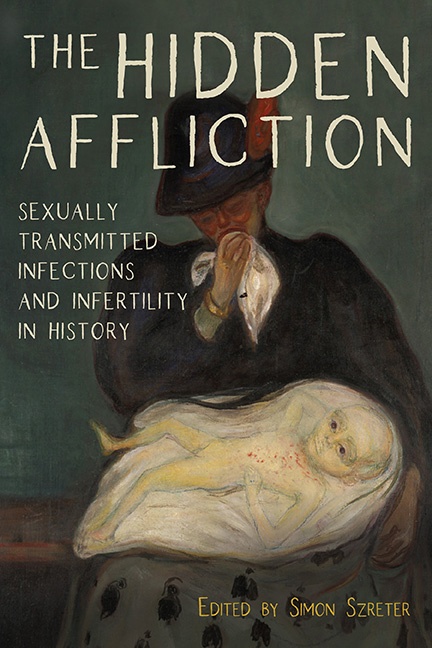Book contents
- Frontmatter
- Contents
- Acknowledgments
- Introduction
- Part One The Hidden Pitfalls in the Early Documentary Record
- Part Two The Biomedical Sciences and the History of the STI Microorganisms
- Part Three Population Decline in the Global South
- 6 Population Decline in Island Melanesia: Aphrodisian Cultural Practices, Sexually Transmitted Infections, and Low Fertility
- 7 Community Infertility in Papua New Guinea: Uncovering the Role of Gonorrhea
- 8 Fertility, STIs, and Sexual Behavior in Early and Mid-Twentieth-Century East Africa
- 9 “A Wise Provision of Nature for the Prevention of Too Many Children”: Evidence from the Australian Colonies
- Part Four Infertility and the Specter of Venereal Diseases in Modern Europe
- List of Contributors
- Index
8 - Fertility, STIs, and Sexual Behavior in Early and Mid-Twentieth-Century East Africa
from Part Three - Population Decline in the Global South
Published online by Cambridge University Press: 25 March 2020
- Frontmatter
- Contents
- Acknowledgments
- Introduction
- Part One The Hidden Pitfalls in the Early Documentary Record
- Part Two The Biomedical Sciences and the History of the STI Microorganisms
- Part Three Population Decline in the Global South
- 6 Population Decline in Island Melanesia: Aphrodisian Cultural Practices, Sexually Transmitted Infections, and Low Fertility
- 7 Community Infertility in Papua New Guinea: Uncovering the Role of Gonorrhea
- 8 Fertility, STIs, and Sexual Behavior in Early and Mid-Twentieth-Century East Africa
- 9 “A Wise Provision of Nature for the Prevention of Too Many Children”: Evidence from the Australian Colonies
- Part Four Infertility and the Specter of Venereal Diseases in Modern Europe
- List of Contributors
- Index
Summary
Problematic Generalizations: Fertility and STIs in African History
Narratives around fertility and sexually transmitted infections in Africa have commonly been characterized by assumptions of universality. Influential theories promoted by Jack Goody and Jack Caldwell identified African cultures as profoundly pronatalist, with the prioritization of the expansion of the lineage causing infidelity to be tolerated and polygamy encouraged. Caldwell and colleagues expanded on this thesis in light of Africa's HIV pandemic, to suggest that pronatalism exposed Africans to a high risk of STI infection. Explanations for the delay in population growth until the 1950s across much of Africa similarly typically focused on gonorrhea and syphilis as the primary cause of subfertility. Moreover, historical analyses of medical interventions against STIs have been consistently negative, owing to a focus on the early colonial experience.
This chapter addresses this tendency toward an assumed homogeneity in depictions of the history of fertility and STIs in Africa. It compares the history of two neighboring societies, Buganda in modern-day Uganda and Buhaya in Tanzania (formerly Tanganyika). It shows that although commonalities in these societies’ experience of fertility change, gonorrhea, and syphilis can be identified, fundamental differences existed in both causation and response. The importance of these findings is threefold. Most obviously, this comparison suggests that if significant levels of variation in local experience over time and space existed, despite Buganda's and Buhaya's core similarities, then assumptions of continent-wide patterns of change should be reconsidered. Second, the analysis of the growing liberalism of STI interventions in Buganda from the 1920s illustrates the capacity of colonial medicine to adapt to both local and metropolitan pressures. The third aspect of this study, which has broader significance, is that, while STI campaigns were most effective where local populations accepted external assertions that subfertility resulted from gonorrhea and syphilis, overall STI interventions’ impact was so great because they provided a vehicle for a broader transformation in reproductive health care.
Buganda and Buhaya: Subfertility and STIs
Buganda and Buhaya, though separated today by an international border (see figure 8.1), share fundamental geographic and cultural characteristics. Their languages are to a large degree mutually intelligible; their social relationships have been shaped by a history of monarchical government; their indigenous religions drew on similar core beliefs and structures; and neither society was especially pronatalist.
- Type
- Chapter
- Information
- The Hidden AfflictionSexually Transmitted Infections and Infertility in History, pp. 249 - 278Publisher: Boydell & BrewerPrint publication year: 2019

